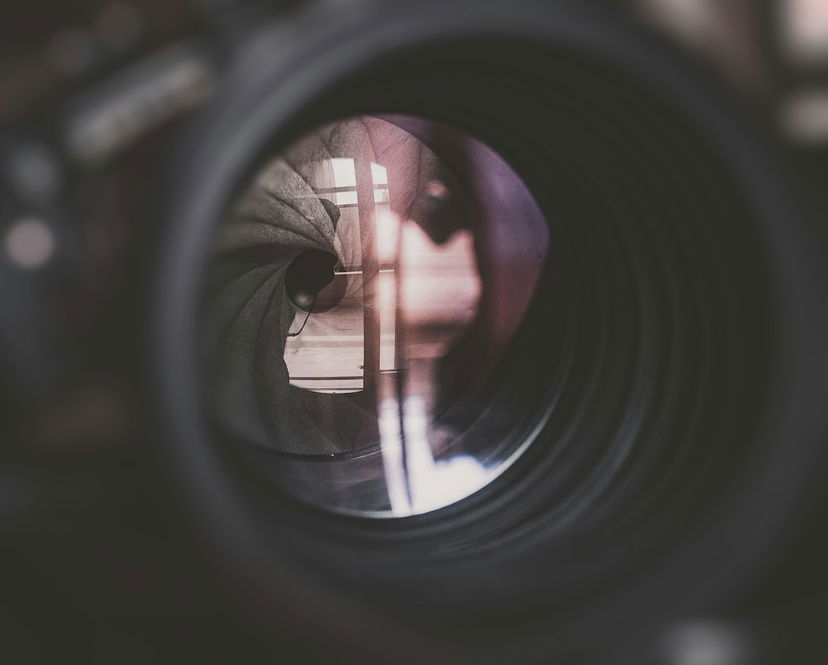AI Photography: How is AI Changing the World of Photography?
Our article goes over AI photography with you. We explore how artificial intelligence (AI) is changing the world of photography.
Photography is constantly evolving with new lens technologies and photo equipment like drones. The newest groundbreaking progression is the incorporation of AI. Digital cameras run on a computer, so there are many ways to improve information processing.
AI Photography: What Is Artificial Intelligence?
Artificial intelligence is a technology with applications in almost any form of computing. This is especially evident where you need a human element to optimize a program.
AI is the process of machine learning. It is the simulation of human intelligence in a computer. Programs learn and keep the information as they progress.
AI produces accurate results due to its familiarity with its environment. The program DeepMind began as an AI playing the 1970s video game Breakout. It played game after game until it found the most efficient way to win.
If you apply this type of machine learning to photography, you could have a machine that theoretically takes perfect pictures!
In practice, there is no program yet with the formula for perfect framing and composition. But AI covers many processes that would be laborious for us to correct. In a nutshell, AI is here to improve our efficiency.
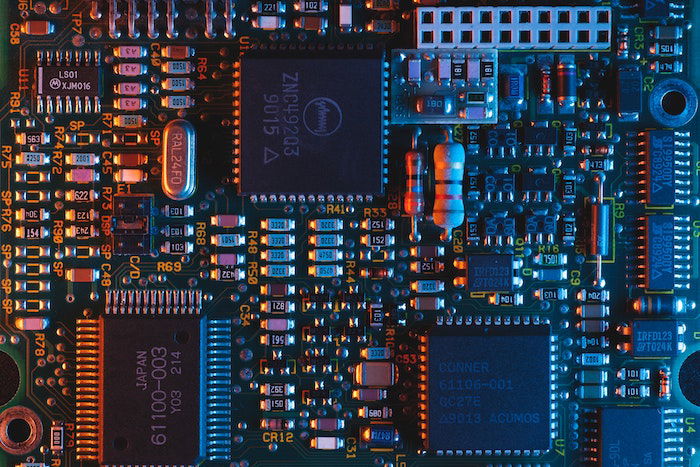
What is AI in Photography?
Manufacturers have integrated AI into photography for a few years now. If you have a smartphone, you already have a range of AI programs at your fingertips.
For example, AI in photography includes your camera’s computer identifying certain subjects. This identification leads to the program making automatic adjustments to the image.
Let’s take a closer look at some examples of everyday AI photography.
Facial Recognition
Most people know that Apple uses facial recognition software to unlock its devices. This software learns your facial features and stores them.
Many photography companies have incorporated the same facial recognition into their cameras. The most common place is autofocusing.
A point-and-shoot camera’s primary function is to photograph people. Facial recognition can scan the scene in real time and then identify if there are faces in an image. The camera will then prioritize the focus to be on the faces.
This removes the need for direct autofocusing on a subject’s face. It is a simple change but a huge step in efficiency. You can find this technology incorporated in most digital cameras.
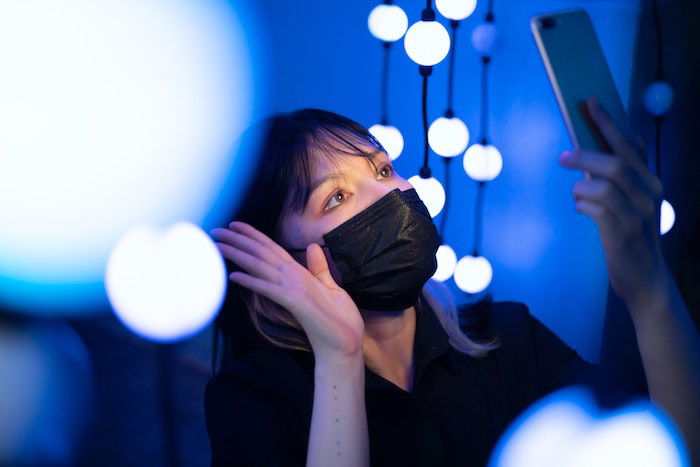
Environment Recognition
Even how a camera reads the environment is part of an AI process. This is evident in smartphone camera settings like Apple’s Portrait mode.
The feature identifies a subject in the foreground. Then it simulates a shallow depth of field. Your subject is entirely in focus. But the background blurs behind it. Thus, it draws more attention to the subject you are trying to photograph.
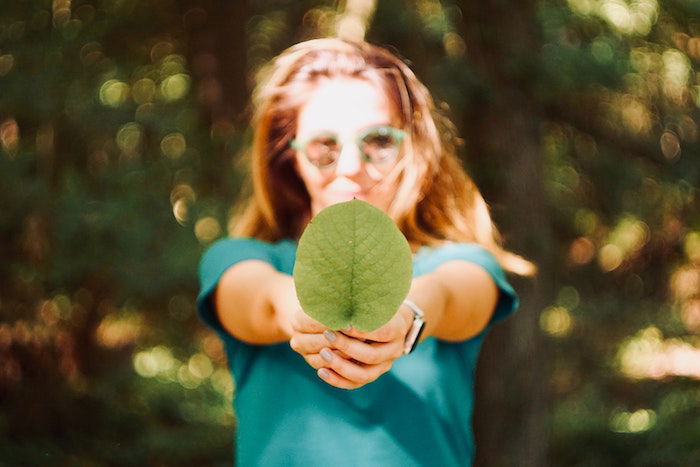
Zoom and Enhance
Both Google and Adobe have zoom-and-enhance programs in development. These AI programs take low-quality images and refine them to give you images you are happy with.
We see this in crime shows and spy movies. And soon, it will become a real option for us in photography software.
These programs will be most helpful in restoring unusable files. If you use a scanner to transfer old negatives and prints onto a digital device, this software will give new life to those images.
Adobe’s program is AI Enhance. It can turn a 0.8 MP (megapixel) image into one with over 3 MP. Even though that doesn’t seem like a lot, the difference is incredible. It can turn a pixelated image into a recognizable photo.
Google’s program uses two processes to enhance pixelated images:
- SR3: This stands for Super Resolution via Repeated Refinement. This process adds noise to the image and pixels it looks at. It then reverses this process and gets rid of the noise. This produces an accurate rendition of the photo. It extracts the most data out of the smallest parts of information.
- CDM: This is a class-Conditional Diffusion Model. This is the process that increases the size of the image. Its AI uses a photo database familiar with high-resolution natural photos. Then it runs the SR3 over the image many times. And the program changes the resolution to its highest.

Zoomed-in and enhanced portrait. (Adobe)
How Can AI Improve Your Photography?
I will now take you through a few cases where AI is available for your photographic needs. These are examples to show you the direction that AI photography programs are going.
Google Clips
Google Clips was the first camera that a computer operated. Yes, there was still a button on it to take your images. But it worked independently, with Google encouraging you to leave it in a good position.
As it was the first full AI camera, Google Clips picked certain moments to take a small video. From those, you could choose your favorite frame. It used AI recognition to identify who to take pictures of. It would remember people important to you. And you could set that by selecting them on the app.
The camera learned what clips you saved and tried to achieve more images or sets like that in the future. You could even set priorities for the camera.
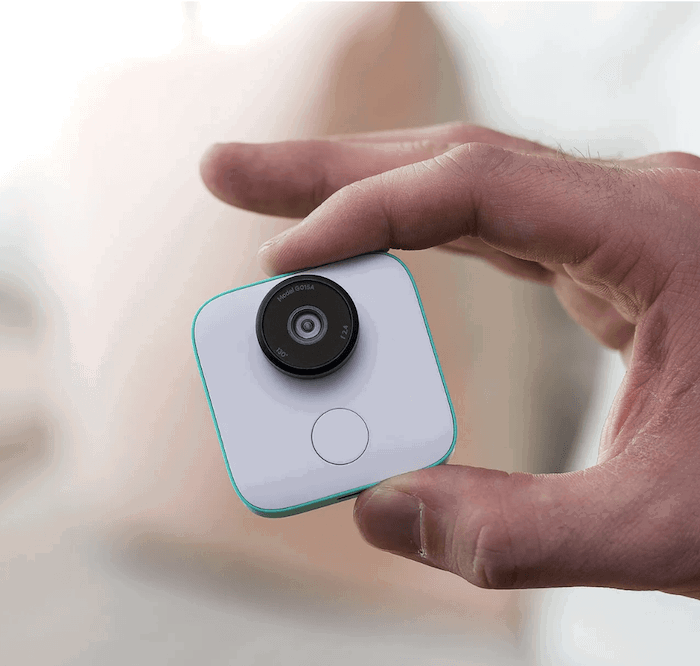
Photo by James Bareham
I didn’t think it looked great if you left the camera in the same position, so I didn’t take many photos that were too different. You had to move the camera around to ensure the pictures were new. I thought the camera quality was lacking.
But it was an excellent addition to your house if you didn’t want to miss out on precious moments. You could capture birthdays, Bar Mitzvahs, and babies’ first steps. And you didn’t have to be behind the camera.
Google discontinued the camera (with support up until December 2021). But this gave us an idea of where AI was heading.
Arsenal 2
Arsenal was the first piece of AI camera hardware that I have seen that you can buy and attach to most DSLR cameras. It is a system that plugs into your camera. And then it aids you with the scene you are photographing.
The Arsenal team claims the program doesn’t take away from photographic originality. That’s because it is still up to you to decide what you point your camera at and how to frame the image.
This program works with a vast database of photos. When you direct your camera to a scene, Arsenal will search its database for similar ones.
The AI software then offers you many settings to capture what it thinks is the best image possible. Thus, it gives you an image like those taken by professional photographers.
They have developed it to recognize action images and to suggest when to use a shorter exposure time. It can also recognize when you need longer exposures. For instance, you can be at the lake’s shoreline. And a long exposure could add a subtle misty effect to the water.
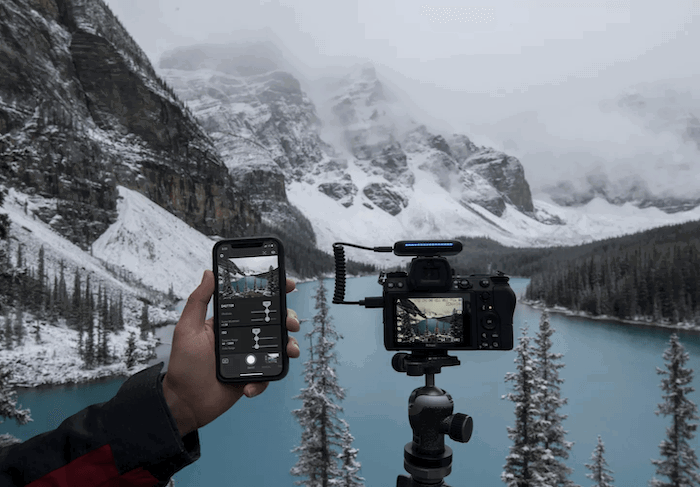
(Arsenal)
Arsenal also offers brilliant efficiency in the context of stacking techniques. It provides options for HDR, focus stacking, bracketing, and more. With a click of a button from your smartphone, the hardware will take the desired photo for you.
Their new feature is Deep Color. Deep Color uses a neural network to develop each photo intelligently. The AI program reads the frame and decides where to enhance specific tones. These enhancements are unique for each environment you encounter.
The AI uses references from its image database to learn what should change. In a way, you have a person with a photographic memory telling you the most successful edit for each of your photos!
Photo Editing with AI
Now, let’s take a look at three software featuring AI capabilities. There is no surprise AI is in photo editing programs. Many editing tools work with computers reading data around them. Then they make predicted reactions that could fit the scenario. Let’s see what companies are offering AI.
1. Skylum Luminar AI
One of the best-known AI photo editing software is Luminar AI from Skylum. It features specific landscape and portrait tools. The Atmosphere and Augmented Sky features create composite edits for you.
They let you choose a range of moods for your photo. The program will read your image, identify the sky, and change the whole image to suit that style. This can save you hours of composite edits in Photoshop.
Luminar AI software also features great tools for photographing people. It includes automatic face and skin editing, which we tested ourselves in our Luminar AI review, among other things.
These features use AI to edit portraits like the pros, saving you from hours of Spot Brush removals. They also have a Portrait Bokeh feature, like Apple’s portrait mode.
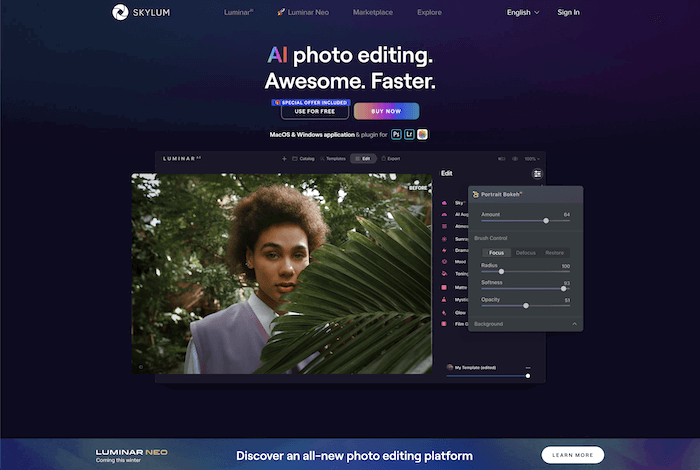
2. Adobe Photoshop
Photoshop is the industry standard for editing software. Unsurprisingly, they have some great features involving AI in the works.
Adobe has a suite of editing tools called Neural Filters. With these features, you can adjust a person’s age and facial expression! You can edit emotions like joy, surprise, or anger through a simple slider.
In the future, Adobe’s AI software will be able to edit critical elements from a shoot, such as the direction of light. It will make an accurate reading of a subject’s face. Then it will apply shadows and highlights to specific areas.
This will make it look as if the lighting is directional. If this software is successful, there could be many changes to how we take pictures. It will affect everything from fashion campaigns to stock images.
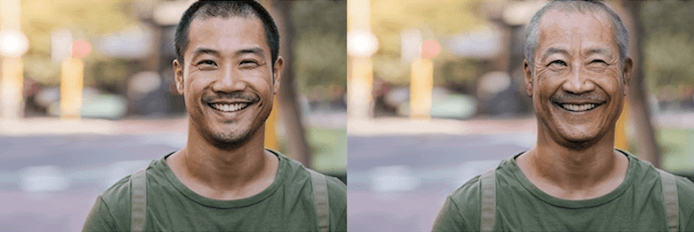
Aging a man using Photoshop’s AI Neural Filters. © Adobe
3. Topaz Labs Photo AI
Topaz is another lab working on image editors. But they specialize in AI software. These tools are only available for zoom-and-enhance purposes. Their software sells as different tools. So you can pick the specific one you need as a one-time payment.
These tools include DeNoise AI, Sharpen AI, Gigapixel AI, and Video Enhance. The titles are pretty self-explanatory and perform great.
I recommend these if you have a recurring problem with your images and want a carefree way of editing. This is great for people who aren’t efficient in editing software such as Photoshop.
You can read our full reviews for DeNoise, Sharpen, and Gigapixel.
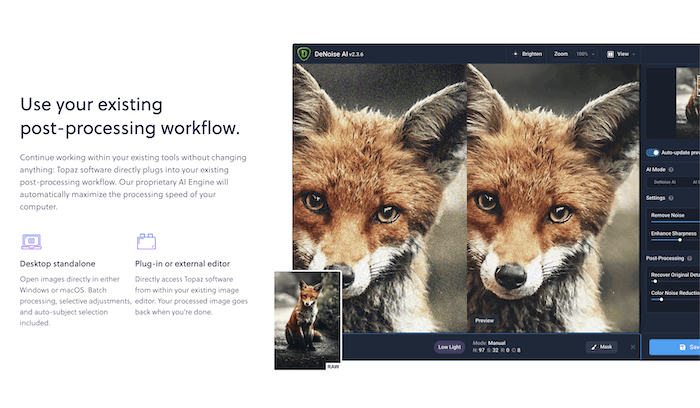
AI-Generated Imagery
Unless you’ve been living under a rock, you know about the new trend of AI-generated imagery. There are a few programs that now work in a text-to-image format. They let you type in prompts for a picture. Then the program generates original images for you.
These images will normally take the aesthetic of digital art. They don’t always produce realistic sizes, forms, and proportions. But you can give them commands that specify to look like a photo.
You can expand upon it in as much detail as you like. You can even ask it to copy the style of your favorite photographers!
You can constantly refine your image in these programs to give more accurate commands. This can help you produce images that will get you close to what you have in mind, but getting them spot-on may be very tricky.
Creating Photos
The two leading programs in this field are DALL-E 2 and Midjourney. But let’s look at some others.
1. ChatGPT
ChatGPT has highlighted that Midjourney software can consider cameras and their settings. This lets you tell the program the camera you want the aesthetic of. To go even deeper, you can suggest a lens focal length, a style, and even an aperture!
The program can then produce some pretty great results. They are fairly accurate to what the camera could produce in real life. This could be a great way to get example images for photoshoots or a great way to produce accurate stock images.
I don’t think these photos will take over traditional photography. Photography is about capturing and conveying realistic items, elements, or food! But ChatGPT may increasingly be used for photo editing and composites. But this industry has been using stock imagery and fake elements since the inception of Photoshop!
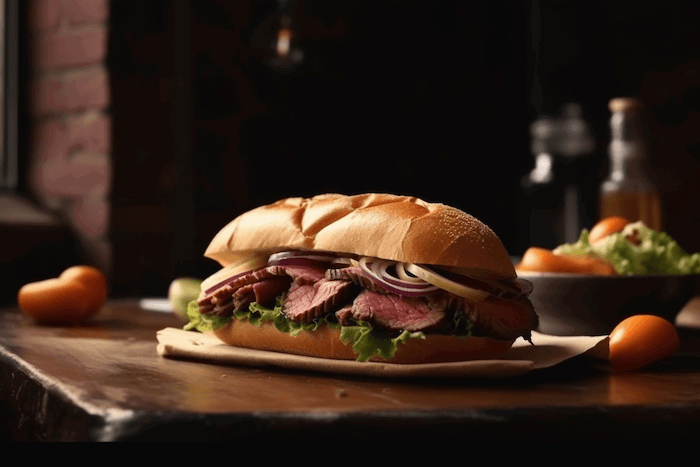
Image made with Midjourney. I used this prompt. “A realistic photo of a New York sandwich with beef and lettuce on the tabletop of a hip restaurant shot on a Canon 5D with a telephoto lens and an f/1.4 aperture.”
2. Booth AI
Booth AI is an AI application that produces product photography using simple commands. This program is a godsend for small start-ups who want to try out a range of product shots. (Or even large companies.)
The platform is extremely simple. And it only takes a few sentences to get your results. All you have to do is upload an image of your product. Then you can set its environment and give it camera commands.
I’m pretty impressed with the results I got from the trial. You can tell it’s AI-generated if you give the photograph proper inspection. But at a glance, it passes for a proper photo shoot! The differences are not too much of an issue. Many companies use heavily photoshopped images for their product photos.
Booth AI also goes one step further and can create adverts using these product shots. You have to enter the text you want and select a few commands. And you’re good to go! This AI process can save you a whole team’s worth of effort. You basically have a whole design team at your fingertips.
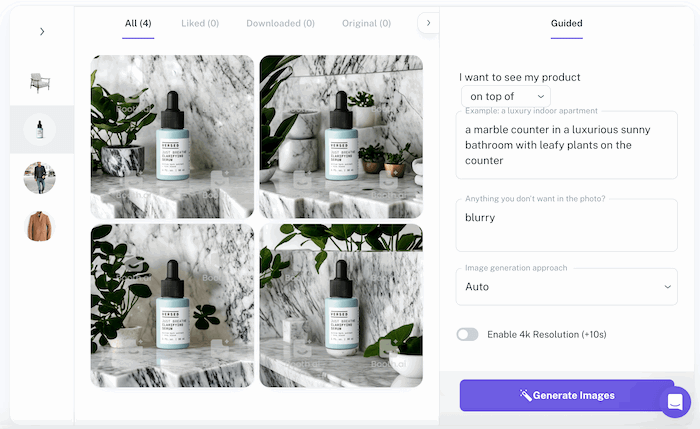
An example of a quick product shoot using the Booth AI application.
3. Photo AI
Photo AI is another site worth noting for AI-generated imagery. This app is specifically built to create photo-realistic portraits of people. The results are incredible.
This can save you a lot of money and time. It’s especially helpful if you want a range of locations. You can now transport yourself to a studio, a busy street, or a flower garden within minutes.
Photo AI defines its application as a Synthetic Photo Studio. You upload real photos of yourself or another person you want the AI to replicate. This creates an AI “character”. Then you can use text prompts to create new portraits of that character.
You can suggest anything in the prompts. This includes everything from clothing to lighting! And the more you train the AI on your digital model, the better results you get.
From the image results from Photo AI, it is extremely close to being believable. Most photos come with this soft look. And to be honest, this soft look is similar to portraits that are heavily photoshopped.
But companies who need photoshoots done quickly can benefit from this AI application. The results are not always perfect. But when it gets it right, the images are mind-blowing.
See our full PhotoAI review for more details, examples, and scores.
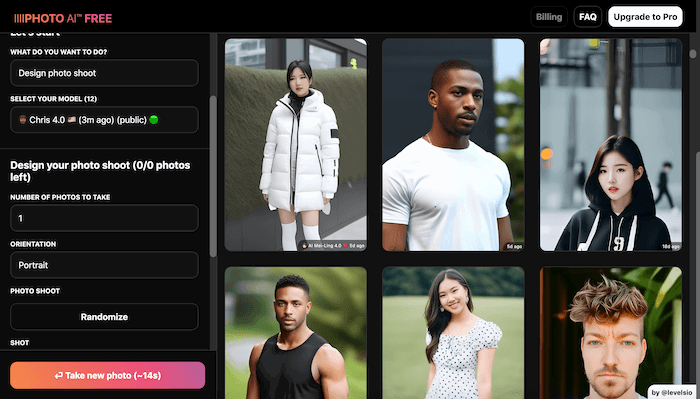
Creating Backdrops
Photographers have already devised a great way to use these programs to their advantage. One method uses this AI-generated imagery for photography to provide exciting backgrounds for product photography.
Some photographers generate backgrounds and edit their products into the scene. This can save people money and prevent creative stress by letting a computer give you several options without trouble.
But your results won’t be as considered as hiring a professional. You must also ensure your editing is good. Otherwise, the effect will be lost. Apps like Booth AI can do this automatically for you!
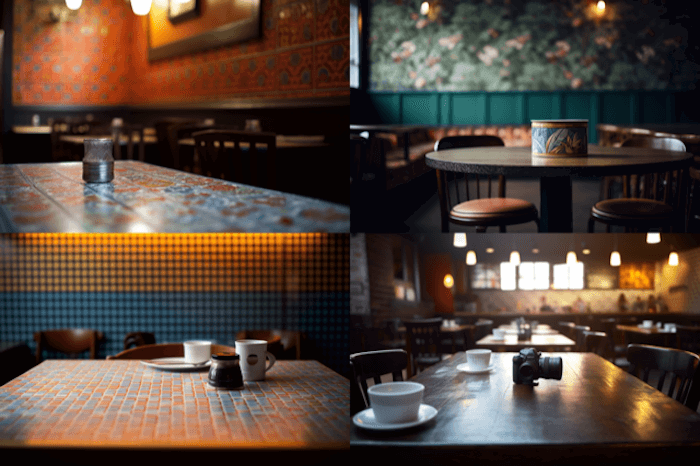
These backdrops were created using Midjourney.
Creating Art
As this is such a big technological step, artists have come to comment on these new systems.
The programs rely on prompts and the networks created. They question how we define different objects. These definitions are based on information collected by a computer.
By asking for a picture of a burger, it will consider all the images of a burger in its database and make a new one based on this information. This can create biases that may produce harmful results in certain situations.
Other artists may want to play with the idea of creating new imagery using another “eye.” Using AI can help produce images that convey a message or story that may not be possible with a camera.
And AI art is hot now. You see it selling for huge sums in famous auction houses. It won’t be long before a gallery near you displays AI art!
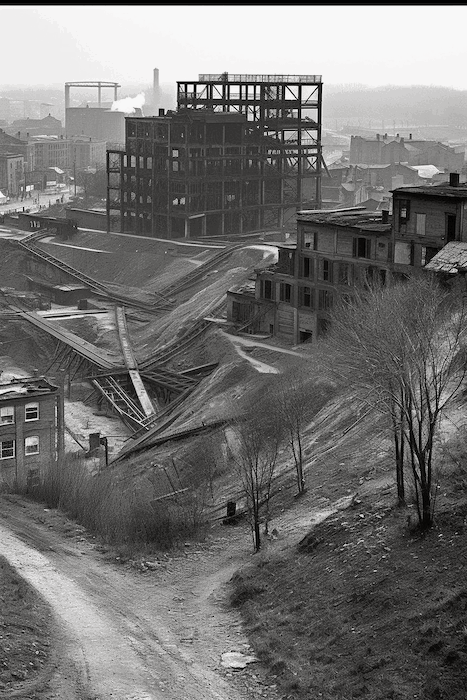
A photo made with Midjourney. I used the prompt, “An art photo of a coal mining district in the style of Henri Cartier Bresson.”
Jasper Art
Jasper Art is known for its text-generating AI abilities. But now, it has stepped into the world of AI-generated imagery.
This application functions similarly to other apps like DALL-E 2 and Midjourney. You type in the prompt. And then, you get a selection of images.
This application could be extremely handy if you already use Jasper Art for your workflow. I prefer the results that Midjourney is currently creating. But the Jasper interface is a lot simpler and easier to work with.
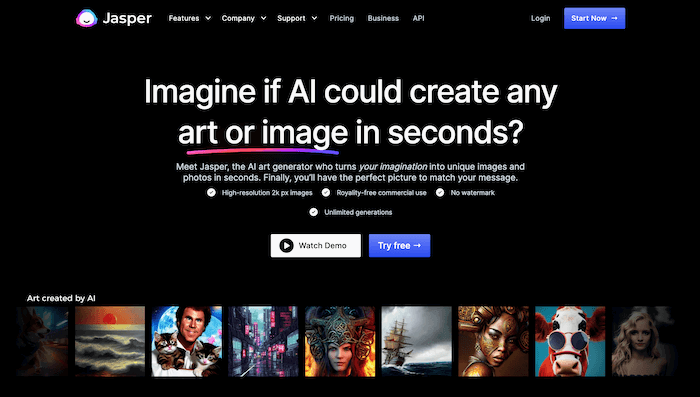
Is Artificial Intelligence Ruining Photography?
You will undoubtedly come across at least one person complaining about AI technology. Some will say it is the death of true photography. I understand where they are coming from. But this couldn’t be further from the truth.
It may be good to consider photo manipulation. It has been around even before the digital age.
Photographers would dodge and burn images with their hands on an enlarger. They even cut out different sections from negatives and imposed them on others to create a new image.
With this in mind, we can perhaps see AI as a natural evolution in photography. AI will not ruin the natural art and expression of photography.
If anything, it will let point-and-shoot photographers achieve better photos. It will also make a significant difference in saving precious images for the future.
Conclusion: How is AI Photography Changing the World?
AI programs and hardware are becoming a common part of photography. This article has shown some of the industry trends with AI photography. And we’ve looked at some of the products companies are working on.
The race is on for developers to build even better AI technology. And we will all benefit from AI in photography. You can continue learning more about AI by reading our article on what an AI camera is!




